She feels really easy and comfortable to sail, even in a good breeze and a chop.
- Slick, stylish decor
- Separate living areas
- Comfort at speed
- Fits a 12m berth
- Tardis-like interior
- Economical cruise 20-21 knots
There comes a time in every yachtie’s life when he/she considers switching to a powerboat. For the Hyde family, the decision to adopt a powered cruising lifestyle coincided with the opportunity to own New Zealand’s first Bavaria Sports Cruiser.
Steve Hyde has been a sailor all his life, cruising on his father’s Farr 38, White Lightning. But he’s not the only yachtie in the family now: son Josh (13) sails out of Auckland’s Wakatere Boating Club and is one of the country’s top Optimist skippers. Steve, wife Leanne and daughter Jemma (11) have increasingly found themselves in the supporter/spectator role.
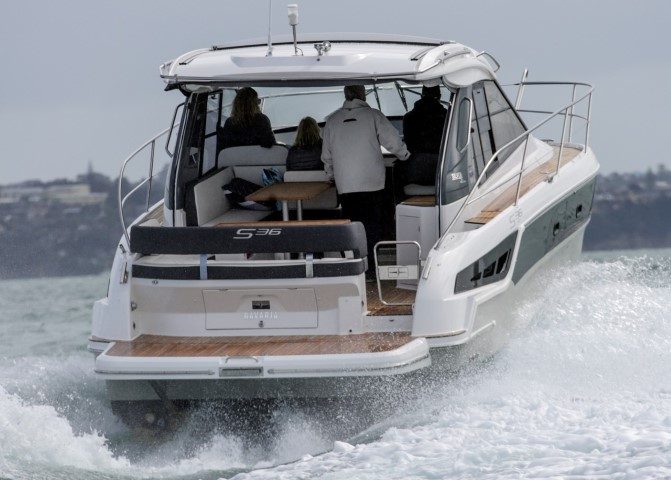
While the Bavaria brand is well-known here for its yachts, this is the first of its powerboats in the country. Silver Lining is an S36 HT — a 10.8m hard-top powerboat with indoor and outdoor living spaces and two separate sleeping cabins – well-suited to family cruising. Built in the same factory in central Germany as the sailboats, it shares a similar construction method and attention to detail.
For Steve Hyde, the decision to switch to a powerboat was a hard but pragmatic one.
“It was about speed – getting to places and maximising the time you can spend there. We’ve been watching Josh from a RIB – now we can watch his progress in more comfort. We can head away for the weekend, come back on Sunday afternoon for him to race, drop him at the yacht club and can go on enjoying our holiday while he sails. With a yacht that’s quite hard to do, and with a beach house it’s even harder. This boat opens up those opportunities.”
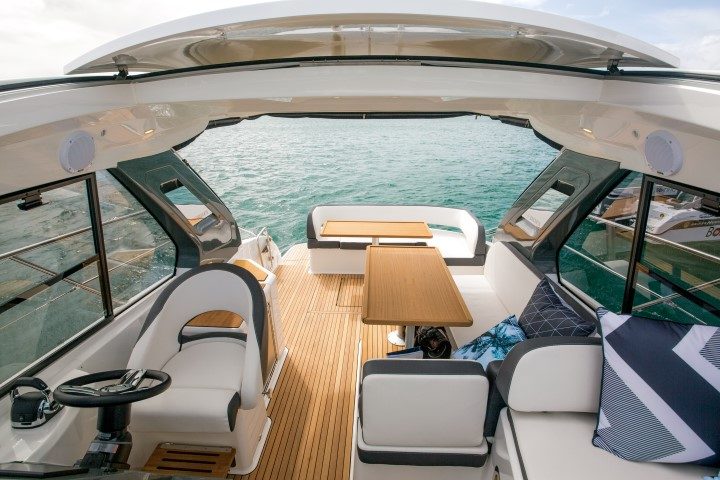
There are other advantages inherent in the boat’s layout. She has three ‘living areas’ – the large cockpit; the upper saloon, a step up from the cockpit; and the main saloon down below. This makes her practical for holidaying with growing kids; everyone can have their own space but still be together.
In the same way, the cabin layout downstairs provides a parents’ retreat in the bow and a separate cabin aft to port, under the upper saloon, with twin beds for the kids. And if there are extra friends aboard, the table in the lower saloon also converts into another double.
The Hydes also wanted a boat that would to fit into a 12m marina berth, and small enough to be handled easily with just the family as crew.
The brand’s German origins also appealed. “We looked at production boats from other countries but felt the German manufacturing was better quality. I’ve been over the boat with a fine-tooth comb and haven’t found any issues at all.”
Leanne was attracted to the layout, with the galley down below but still close to the action in the upper saloon. She also liked the large through-hull windows in the downstairs saloon, and the large hatches above which provide light and a sense of space.
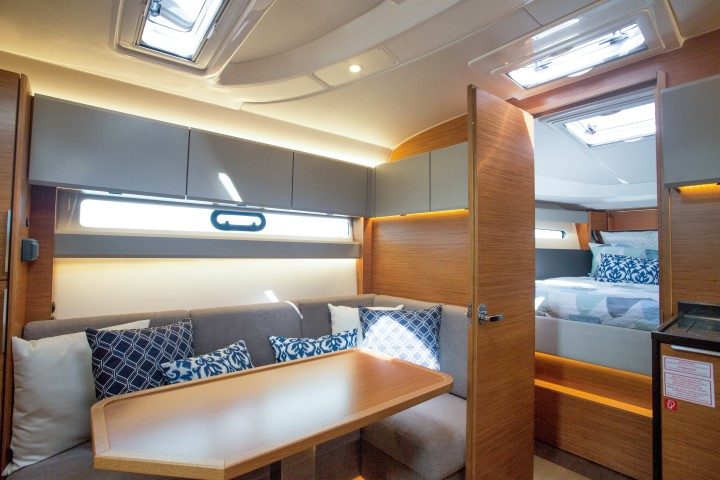
The family wanted a boat which could cruise comfortably and get out to the Barrier and up to the Bay of Islands quickly. Over summer they plan to head off for up to two weeks at a time, so having ample stowage for provisions and the ability to be self-sufficient for long periods was another plus for Leanne.
ON BOARD
The S36 certainly makes the most of its 12m berth – the Hydes opted for the extension to the rear boarding platform to create a large space for fishing and swimming, and plan to fit rod holders, a barbecue bracket and davits for the dinghy.
In the Coupe version of the S36 the upper saloon can be enclosed with doors at the back. The Hydes have opted for the HT model, which is open to the cockpit for ease of summer living.When the weather’s uncooperative, the entire cockpit can be surrounded by clears, creating a large extra ‘room’.
There is a large bench seat across the transom, and currently a table. One step up and under cover of the cabin-top is the upper saloon, with L-shaped seating to port around another table, and a wet bar with fridge and sink to starboard. With good planning you could have a long drinks-and-nibbles session here without having to go down below for replenishments.

You can see how this will become the main ‘entertaining’ area in summer, with large windows all around for letting in the view, and a massive sunroof – great on summer days. The Hydes have selected solid teak for this area – it adds a touch of colour underfoot.
Opposite is the helm station, with a generous bench seat for the skipper. Controls are simple: throttle, trim tab and bow-thruster controls at hand to starboard, and a touch-pad to control lights and other systems to port. The Garmin chartplotter in front of the wheel is standard; the Fusion stereo an optional extra.
There are a couple of nice design features here; the end seat of the ‘L’ has a back which flips position like an old-fashioned train seat, so you can travel facing forward, or sit facing aft around the table. But the prime travelling spot – and one which is already been keenly-contested among the family – is forward of the saloon seating, up on the ‘dash’, with an upholstered backrest and comfy squab to stretch out on while getting a grandstand view of where you’re headed.
The interior is quite Tardis-like, expanding before you as you descend the companionway steps. The boat’s high topsides come into play here, creating a large interior volume, with full headroom. There’s another L-shaped settee and table to port – the Hydes have deployed a couple of fabric poufs to add extra seating – and the galley to starboard, with a smart, solid-surface black benchtop, twin sinks and an integrated, under-bench fridge-freezer. The cabinetry is teak with walnut flooring, and the upholstery’s a soft, earthy tone. Light and practical.
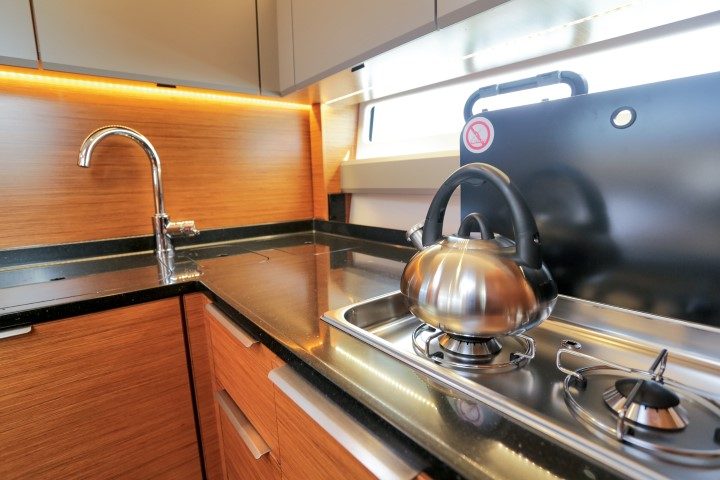
Aft of this lower saloon, to port, is the twin cabin, with plenty of storage, a decent-sized window and a settee, the squab from which can be used to convert the beds into a double. Although the beds are tucked athwartships under the upper saloon, there’s plenty of headroom and it doesn’t feel cramped or poky at all. To starboard, aft of the galley, is the head and shower, with an electric toilet and plenty of room for ablutions. This room also has its own window to let in plenty of light.
The master cabin’s in the bow, with a truncated, diamond-shaped bed – tricky to make but a good use of space. It can also be extended for extra-large guests. Through-hull windows make this a very pleasant spot to relax with a bit of privacy, yet still enjoy the view.
And just to make it super-comfortable, the Hydes ticked the box for upgraded memory-foam mattresses and blackout blinds on all the windows. These descend from their hiding places behind little pelmets to ensure a good night’s sleep.
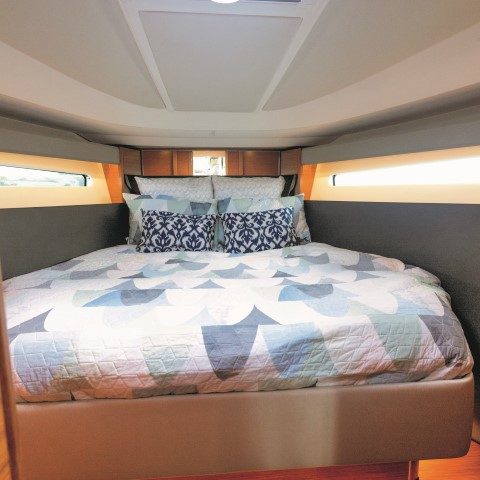
UNDER POWER
The S36’s powered by a single Volvo 370hp diesel – an option the Hydes decided would save weight, maintenance and cost. For ease of manoeuvrability a bow thruster’s been included. It certainly comes in handy getting in and out of the marina berth in a fresh cross-wind.
This is only the boat’s third outing, but Steve has had it close to its cited maximum speed of 32 knots. It seems happy cruising at around 23-25 knots, using around 27 litres per hour. It’s more economical at around 20-21 knots. That’s still plenty of speed to comfortably get to Kawau or the bottom end in little over an hour.
The Volvo’s surprisingly quiet, even when we’re powering along in the mid-20s, and we’re easily able to chat. The ride is comfortable too; I can still take (readable) shorthand while making short work of the bouncy Waitemata chop.
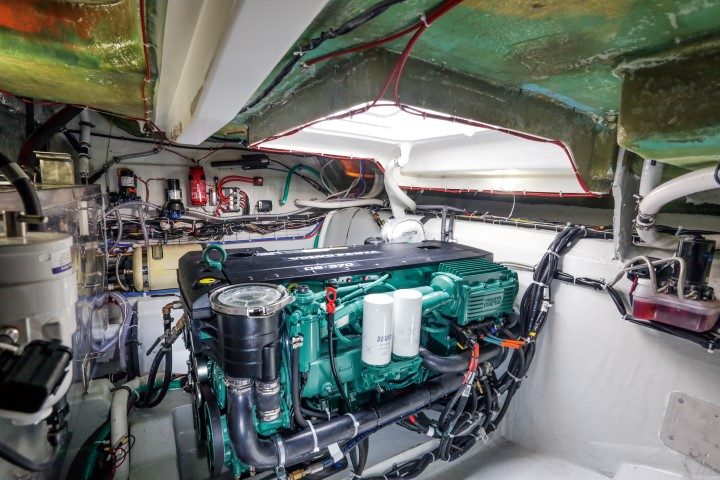
Steve experiments with the trim tabs to get the ride as balanced as possible, and the foredeck remains dry despite bounding over a few waves. As broker Colin Rees of Busfield Marine says: “The boat’s designed to handle rough, short chop conditions you get in the Mediterranean, – well-suited to our waters.”
We anchor off Wakatere for the photo shoot. Despite the inclement weather, we grab the chance for a patch of sunlight to deploy the sun lounger on the bow for the first time. There’s plenty of space – and drink holders – up here and it’s hard to know if this area will be colonised by the kids or the parents.

It’s easy to get up to the bow, with a walkaround both sides, a high railing and grab-rails on the cabin-top. But you don’t need to go forward to deploy the anchor; that’s all push-button from the helm station. This is the first time the boat’s been anchored, and everything runs smoothly.
Rain/hail is threatening again, so it’s time to head back to Westhaven. For a yachtie, Steve looks extremely content behind the wheel, and Leanne very comfortable in the ‘shotgun’ seat. It looks like it won’t only be the kids happily playing with the new toy this summer.
She feels really easy and comfortable to sail, even in a good breeze and a chop.
At first glance the boat appears to be a large centre console, although hidden beneath the console and forward area is a sizeable overnight cabin.
With classic styling, good performance and class-leading ride and handling, there’s a lot to like about the Caribbean 32.
Solar panels on the vast roof help keep the batteries charged.